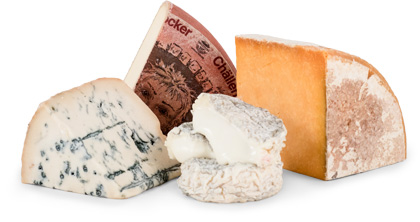Legend has it that a young shepherd was guarding his herd of ewes near the Grotte du Combalou, a large cliff face that dominates the village of Roquefort-sur-Soulzon in the beautiful Aveyron region of south central France. He was just about to prepare his midday meal when he noticed a beautiful young lady in the distance. Fascinated, he attempted to follow her. He left his dog to look after the herd and hid his lunch—of bread and cheese—in the cool, damp rocks of a grotte ("cave" in French). Sadly, the shepherd never found the young woman and returned to his herd disappointed.
Months later he came upon the lunch that he had hidden. The bread had decomposed, leaving the cheese with streaks of blue veins. In a move most of us today would question, he tried the abandoned cheese and found the taste remarkable. Thus Roquefort cheese was born. It did not take long for the shepherd to share this alchemy of milk, bread, air and time with his fellow herdsmen. Soon many caves had been converted into cabanes en bois or "huts of wood," so named for the oak planks built in the interior of the caves where cheeses are left to ripen.
Roquefort cheese is said to date back to the time of Pliny the Elder in ancient Rome (circa 75 AD), and the center of Roquefort cheesemaking has always been Roquefort-sur-Soulzon. The cheese's name-controlled AOC status is probably the oldest in all of France. Today it's made with pure sheep's milk which is inoculated with a special type of blue mold, penicillium roqueforti, obtained from bread left to mold in the caves of the Combalou Mountains, where the original Roquefort cheese was accidentally created. Ripening is of paramount importance and takes a minimum of three months. Cheese that can legally be sold as Roquefort is ripened in only one area—in the caves of Roquefort-sur-Soulzon in the chalky Combalou Mountain area. The region has an abundance of caves due to a geological accident that occurred long ago. Then an extensive clay bed partially collapsed in the same region, creating vertical faults and fissures in the caves which provide ventilation, a necessity for making the cheese.
Roquefort begins, as all cheese does, at dairy farms, where it's salted and then pierced with needles. It is then placed in the caves, on top of oak planks in long rows filling the natural caves. There the cheese matures under the careful watch of maîtres-affineurs, or master "maturers." The well-known green-blue marbled appearance of Roquefort develops when the cool, damp air is swept into the caves through the fissures, developing the roqueforti mold in the cheese's pierced channels.
To prevent Roquefort from drying out and to ensure that its deliciously unctuous texture remains well preserved, it should always be kept in its original wrapping or protected by a sheet of aluminum. Since most of us don't have a damp, cool cellar in which to store our cheese, keep your Roquefort on the lowest shelf of the refrigerator. As with other fine cheeses, avoid drastic changes in temperature, as this can ruin the cheese.
Roquefort has a tingly pungent taste, a distinct bouquet, and a flavor that combines the sweet burnt-caramel taste of sheep's milk with the sharp, metallic tang of the blue mold. When destined for a cheese board, Roquefort should be brought to room temperature at least one hour before being served, just like a good wine. Only at room temperature will it offer the full splendor of its aroma, softness, and sophisticated flavor. Serve it after dinner with sweet fruit and wine – a perfect dessert.

Experience International Variety
You might receive a Gaperon, originating in France during the 14th Century, an
authentic Lancashire by Ruth Kirkham, and an Italian Taleggio matured in the
caves of Valsassina…all in one shipment!

